Annals of the MBC - vol. 2 - n' 2 -
June 1989
THE
TREATMENT OF SUPERFICIAL BURNS WITH BIOLOGICAL AND SYNTHETIC MATERIAL: FROZEN AMNION AND
BIOBRANE
Lorusso R, Geraci V., Masellis M.
Divisione di Chirurgia Plastica e Terapia delle
Ustioni, Ospedale Civico, U.S.L. 58, Palermo, Italia
SUMMARY. An
analysis is made of the manner of recovery, the capacity for preventing infection and the
operative and economic advantages when using frozen amniotic membrane and a biosynthetic
membrane (Biobranc), in the treatment of superficial bums. The parameters considered
include: - type of burn - assessment of bacterial pollution at time of admission and at
subsequent medications - assessment of adherence - time and manner of recovery. The
results obtained from the comparative examination of burned surfaces which were similar
from the point of view of type and depth of lesion made it possible to appreciate the
effectiveness of the two epidermis substitutes as regards manner and quality of recovery.
It is pointed out that amniotic membrane is economic and readily available, especially if
repeated medications are necessary.
The ideal substitute of the epidermis must
possess many of the properties of human skin, i.e. it must be adherent, elastic, resistant
and haemostatic.
It must also constitute a barrier against bacterial contamination; it must be easy to
apply and to remove; it must be sterilizable; and it must allow exchanges of water vapour
permitting the appropriate degree of humidification at the level of the lesion in order to
prevent dehydration and consequent deepening of the wound. It must be atoxic, devoid of
antigen power, and sterile. Other important factors are ready availability and low cost.
Adherence is perhaps one of the most important factors, as close contact with the
deepithelized surface reduces pain and infection and promotes reepithelization.
We have found all these characteristics in amniotic membrane in some 8 years of topical
therapy and of surface burns. The preparation, sterilization application of amnion have
been standardized, the results have confirmed our expectations.
For some years various types of synthetic epidermis substitute have been available. We
accordingly decided to compare the advantages of a blosynthetic membrane (Biobrane) and
those of amnion.
Materials and methods
Eleven patients suffering from second
degree superficial and deep bums, without bulla epidermis, were treated with applications
of amnion and Biobrane (Tab. 1).
The two substitutes were applied to contiguous surfaces or in burned areas which appeared
to have similar depth on hospitalization. The following contrastive parameters were
analysed: type of bacterial contamination before application of the dressings, adherence,
presence and quantity of secretions in relation to the type of burn, to BSA, to days of
hospitalization and to recovery according to type of dressing (Tab. 2).
Bacterial contamination was determined by using smear swabs on a surface of approximately
one square centimetre before dressings were applied. After debridement the surfaces were
not treated with antiseptic or antibiotic substances.
The treated surface was examined on day 2 in order to evaluate adherence, the presence of
secretions and the necessity of substituting non-adhering membranes, after taking a
microbial flora swab. The same procedure was repeated on day 4. If deeper burn areas were
detected during successive medications, these were treated with antiseptic-antibiotic
proteolitic substances and covered with vaseline gauze.
In all cases, except two in which there were areas of deep second degree burn, the
complete adherence of the dressing and the rarity of secretions, which in any case were
serous, did not require the use of further swabs.
Evaluation, on the basis of progressive positive signs, of the adhesive qualities of the
two materials indicated the excellent adherence to the burned surface of porous Biobrane,
which was comparable to that of amnion. In all cases treated with amnion or Biobrane only
one dressing was necessary for complete healing.
| Name |
Years |
Burn
ag. |
%
BSA |
Degree
burn |
Days
hosp. |
AMNION
days
healing |
BIOBRANE
days
healing |
Outcome |
| A.R. |
2 |
Water |
12 |
II sup. |
7 |
6 |
6 |
- |
| M.L. |
3 |
Coftee |
7 |
II sup. |
8 |
7 |
7 |
- |
| G.M. |
1 |
Water |
4 |
II deep. |
20 |
Removed on day 4 |
Removed
on day 4 |
Graft |
| A.C. |
46 |
Flame |
5 |
II sup. |
17 |
10 |
10 |
- |
| G.P.M. |
2 |
Flame |
6 |
II sup. |
11 |
4 |
5 |
- |
|
|
|
|
II deep.
palm left h. |
|
|
10 palm
left h. |
- |
| M.L. |
2 |
Water |
5 |
II sup. |
7 |
6 |
5 |
- |
| C.F. |
5 |
Water |
7 |
II sup.
and interm. |
19 |
17 |
12 |
- |
| S.G. |
3 |
Water |
8 |
II sup. |
12 |
- |
11 |
- |
| A.P. |
1 |
Water |
4 |
II sup.
and deep. |
29 |
10 |
10 |
- |
| L.R. |
1 |
Milk |
6 |
II sup. |
7 |
6 |
6 |
- |
| F.I. |
40 |
Water |
10 |
II sup. |
9 |
8 |
8 |
- |
|
Table 1 |
|
| Region treated with
AMNION |
Region treated with
BIOBRANE |
Swab on entry |
Swab Day 2 |
Swab Day 4 |
Adherence Day 2 |
Adherence Day 4 |
Secretion Day 2 |
Secretion Day 4 |
| Right forearm |
Left
forearm
|
L.A. Staphyl. |
- |
- |
++++* |
++++ |
- |
- |
| and hand |
and hand |
rare colonies
R.A. Staphyl. epid. |
|
|
++++** |
++++ |
- |
- |
| Thorax |
Right arm |
Staphyl. epid. |
- |
- |
++++ |
++++ |
- |
- |
| |
|
Idem |
|
|
++++ |
++++ |
|
|
| Left wrist |
Right forearm |
No development |
- |
- |
+++ |
+++ |
- |
- |
| Right forearm |
Left arm, forearm
|
Staphyl. Aurcus |
Staphyl. |
- |
+++ |
+++ |
++ |
+ |
| |
and hands |
No developmen |
Aureus |
|
++ |
++ |
|
|
| Back of |
Back and palm |
No development |
Acinctobacter |
Staphyl. |
++++ |
++++ |
++++ |
- |
| right hand |
of left hand |
|
palm left hand |
Aureus |
++ |
++ |
|
|
| Right thigh |
Left thigh |
Mixed flora |
- |
- |
++++ |
++++ |
+ |
- |
| |
|
rare colonies |
|
|
++++ |
++++ |
|
|
| Left gluteus |
Right gluteus |
No development |
- |
- |
++++ |
++ |
- |
+ |
| Left forearm |
|
|
|
|
++++ |
++++ |
|
|
| Right leg |
Left foot |
No development |
- |
- |
++++ |
++++ |
+ |
- |
| |
Right leg, foot |
|
|
++++ |
++++ |
|
|
|
| Thorax |
Thorax |
No development |
- |
- |
++++ |
++++ |
- |
- |
| |
Right forearm |
No development |
|
|
++++ |
++++ |
- |
- |
| Abdomen |
Thorax |
No development |
- |
- |
++++ |
++++ |
- |
- |
| Right forearm |
Post. thorax |
No development |
- |
- |
++++ |
++++ |
- |
- |
| Right post. thorax |
|
|
|
|
+++ |
+++ |
|
|
|
Table 2 |
|
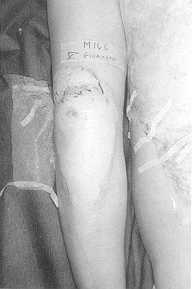 |
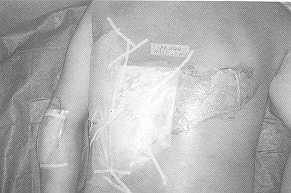 |
| Case 1
Photo 1 |
Case 1 Photo 2 |
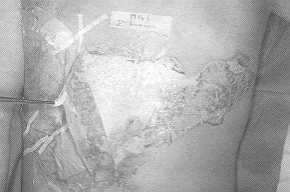 |
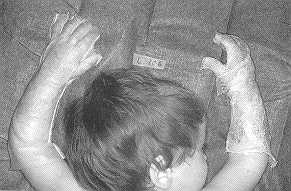 |
| Case 1 Photo 3 |
Case 1 Photo 4 |
|
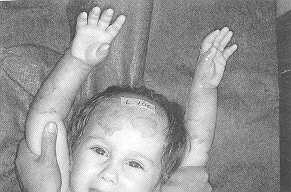 |
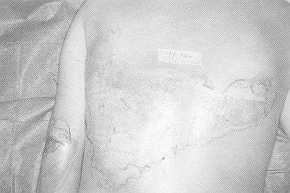 |
| Case 2
Photo 1 |
Case 2 Photo 2 |
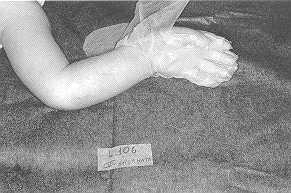 |
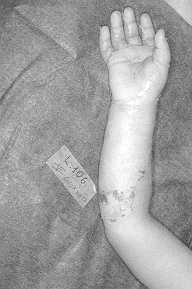 |
| Case 2 Photo 3 |
Case 2 Photo 4 |
|
Conclusions
A comparative study of amnion and Blobrane as
epidermis substitutes in superficial burns of similar type and depth indicated their
therapeutic efficiency in both quality and speed of healing.
A proven system of supply and preservation
of amniotic membrane, and an efficient sterilization technique, make amnion much more
competitive from the economic point of view. This is even more evident when dressings have
to be frequently repeated and when extensive burn areas have to be covered.
RÉSUMÉ. Les Auteurs analysent, dans le
cadre du traitement des brûlures superficielles, la manière de guérison, la capacité
de prévenir l'infection et les avantages opérationnels et économiques de l'emploi soit
de la membrane amniotique congélée soit d'une membrane biosynthétique (Biobrane). Les
paramètres considérés sont: - le type de brûlure - lévaluation de la pollution
bactérienne au moment de l'hospitalisation et des pansements successifs - l'évaluation
et la manière de guérison. Les résultats obtenus par l'examen comparatif des surfaces
brûlées sont semblables du point de vue du type et de la profondeur de la lésion, et
ils ont permis d'apprécier l'efficacité des deux substituts de l'épiderme pour ce qui
concerne la manière et la qualité de guérison. On souligne que la membrane amniotique
est facilement disponible et économique, surtout s'il faut effectuer des pansements
répétés.
BIBLIOGRAPHY
- Brown AS et al.: Biologic dressing and skin
substitutes. Clin.Plast. Surg., 13 (1): 69-74, 1986.
- Hansbrough J.F. et al.: Clinical experience with
Biobrane biosynthetic dressing in the treatment of partial thickness bums. Bums, 10:
415-419, 1984.
- Masellis M., Vitale R., Lorusso R, Sucameli M.,
Geraci V.: L'amnios congelato come sostituto biologico della cute nel trattamento delle
ustioni superficiali. XXXII Congresso Nazionale della S.I.R.C. Tomo 11, 1339-1349.
- Robson M.C. and Kritzek T.J.: Clinical experience
with ammotic membranes as temporary biological dressing. Conn. Med. 38: 499, 1974.
- Trelford J.D., Trelford-Sauder M.: The amnion in
surgery, past and present. Ann. J. Obstet Gynecol., 134: 833-45, 1979.
- Vitale R., laia A., Sferrazza G., Masellis M.:
Frozen amnion: a biological dressing for human wounds. Riv. Ital. Ch. Plast., 13: 1-2,
1981.
- Woodroof E.W.: Biobrane, a biosynthetic skin
prosthesis. In: Wise D. (ed): "Bum wound coverings". C.R.C. Press, Inc. Boca
Raton, Fla., 1984.
|







